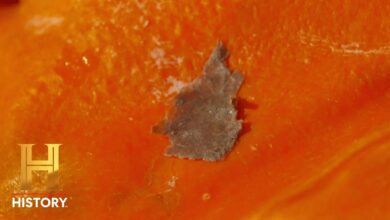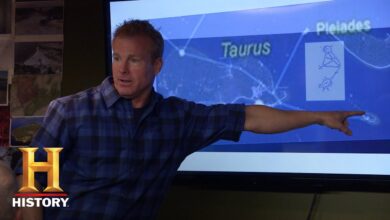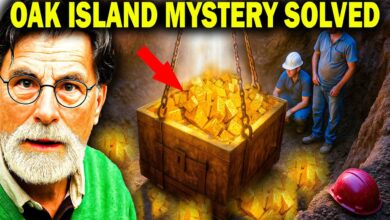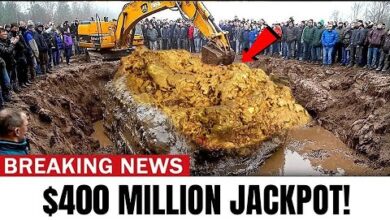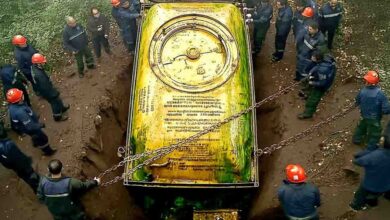Multiple Treasures Buried Underground (Season 12) | The Curse of Oak Island
Multiple Treasures Buried Underground (Season 12) | The Curse of Oak Island

I don’t think I’ve seen a full war room
like this for a long time meaning it’s
going to be quite exciting. Rick Lagina
has called an important meeting with the
team in the war room. We have to follow
where the clues lead us and the clues
come from the research after the recent
discovery of the mysterious empty
vault-like structure in the swamp. Rick
asked team members Doug Croll and Judy
Roudabush, along with historian Terry
Devau, to search through different
archives known to contain previous
searcher records connected to the Oak
Island mystery. Terry and Doug went down
to the Connecticut Museum of Culture and
History. It was Rick’s hope that they
might uncover clues that could help
prove Fred Nolan’s theory regarding
multiple treasures being buried on Oak
Island.
So, Doug, I’ll turn it over to you.
Well, this Oak Island material that we
found in Connecticut really is due to
the work of Terry Devau, and amongst the
things that he was researching down there,
he noted this particular individual,
whose face I think you should be able to
see on the screen now: William B.
Goodwin. In the early 1930s, Connecticut-based businessman and
historian William B. Goodwin began
researching the various treasure hunts
that had taken place on Oak Island since
the Money Pit’s discovery in
1795. Throughout his life, Goodwin amassed
a collection of documents pertaining to
the mystery, especially records connected
to Frederick Blair, the man who first
reported the existence of the so-called
Chapel Vault, 153 ft deep in the Money Pit, back in
1897.
So, we found several letters in 26
boxes of Goodwin’s collection that had to
do with Oak Island, and Judy and I have
spent some time trying to determine what
it all means. And one of the things here
we found in his notes on Oak Island is
Goodwin calls it the Blair treasure map.
Oh yeah, Blair had in his possession a
treasure map. Goodwin saw that map during
his time here, and this is his diagram and
notations. So this isn’t the original
Blair map. We don’t know where that might
be because nobody’s ever been aware of it.
So, there were three original notations on
the map, three stones that were indicated,
and from what we can gather from William
Goodwin’s notations, he was trying to
figure out if this map meant there were
three separate treasure caches
associated with the west end of the
island.
Gary, have you hammered this area?
No, I haven’t, Marty, because it’s so rough.
It’s as rough as a badger’s butt out there.
I mean, there’s all illy mounds that Roy
would say the stone on the beach that
seems to be the place to start. Did we go
looking for these landmarks, find the
stones that are the original landmarks
on the original map, and try to find out
whether there’s any treasure caches
nearby? This is good work. This is
excellent work. It may lead us to
something. Marty’s right. We follow the
clues as we have currently interpreted
them, so I say we get after it. Let’s go
look.
Alright, let’s see if we can find the
treasure. The Goodwin map delineates
several boulders on lot one. It’s a
treasure map; it has an X marks the spot.
I mean, it’s classic. Let’s look in this
direction. Okay, we’ll check out this way.
Okay, mate, we’re looking for a big flat
stone. It’s supposed to have a big X on
it. We need to find a really good clue,
something old, a coin with an intriguing
date, anything like that. We’re going to
see if there’s anything really actually
special about these boulders.
Well, there’s a flat rock right
there. Oh, and it does have a big ACC on
it. Oh, yeah, yeah, look. Oh, it really does,
and no mistaking that this is in the right spot,
a carved X on a flat boulder just as the
believed treasure map indicated.
Hey guys, check this out. Could that mean that the
team may be on the verge of a major
discovery? Look at that, a very prominent
X. Yeah, right. Let’s see if there’s
anything around it and see if there’s
any metals under it as well, because if
there was something under it, I’d detect
it with this, right? Well, we’ll stand back
and give you room.
No, nothing underneath it made of
metal. No, there’s no metals around it or
underneath it, not that I can detect.
According to the notes, this next
stone had an X and the square shapes on
it, and I think we found it. Really? Yes.
Lead us to it.
Okay, look at here, guys. Seams and
squares. Look at this. The original
description said that it had an X on the
stone in the center of it. There’s a seam
of an X here, so this has got to be the
stone. But we ain’t going anywhere till
we metal detect that. Look at the
treasure! That’s a treasure map.
I go around it, and then on top of it
here we have a point on a treasure map
that truly exists. These are real
landmarks. What does it all mean? We have
to work to find that out.
I’m not getting any hits,
unfortunately, but this might be markers
sending us somewhere else to find the
treasure. And that’s the thing: the map,
the way they were interpreting it off
this rock, is supposed to be 91 ft back
inland, parallel to Center Road. So, we run
a tape in that way. There should be a
kidney-shaped rock. So, if that kidney
rock’s here, we’re in
business.
We’re aiming to try and keep
the same bearing as the road, and what
shape is the stone? It’s kidney
shaped. Doug, hold up, that’s it! 91
ft! So at 91 ft, there’s one stone here.
Look how it comes in like that way, like
a kidney bean. Yeah, this is more kidney
bean shaped. If you’re using natural stones
as markers, then that’s the most fitting
description of the shape of this stone.
Well, bloody H, mate, we’re three for three
now. Well, what’s got me excited is the
landmarks seem to be proving true. Yeah,
the fact that we found every single
landmark that’s on the map, it shows the
map as completely valid for me. Time for
some metal detecting! I can’t wait to see
where this leads us.
There we go! Maybe the positions of the
rocks are important, and maybe the
positions of the rocks will help solve
the mystery. I haven’t got any metals
around the rock or on top of the rock,
but you’ve seen the area. Billy’s guys
have got to do some serious clearing in
this area. But we’ve got one more major
landmark to find. What’s the description
of that boulder, Judy?
It has a top cleaved off like lightning
hit it. Let’s go to that fourth one and
hopefully hit the jackpot. Let’s see if we can find
it.
Oh, that’s what we’re talking about.
Yeah, no mistaking this.
One looks like it was cleaved in half by
lightning. I can see both sides right
there, and it looks like it was blasted
apart. Oh yeah, look at that. Let’s see…
Ringing loud and clear. That’s
been pinpointed. Oh, oh, singing loud and
clear, rapid vibration! Wow, look at that!
Pin, yeah, that’s not rubber. This is an
old and forged piece of iron. If I was
putting a date on this, I’d say you’re in
the 1700s or a lot older.
Really? Wow. And that came from right
underneath the boulder? Yeah, it sure
looks like some kind of cribbing spike
that you would use for tunneling.
Okay, weren’t the swages found nearby?
Yeah, they’re a stone’s throw away over
there. Maybe someone was
tunneling, who knows?
Is it possible that the team has
just found another critical clue to help
prove the authenticity of this treasure
map? If so, could that mean that
something of great value is actually
buried in this
area?
You know what? It does for me. It
takes this from a rock on a map to a
place where there’s been human
intervention. Someone’s been looking here
or depositing something. I think what we
got to do is go back and inform the guys
of what we found in regards to this map.
It is a top pocket find as far as I’m
concerned, but unless you guys are paying
me laundry bills, it’s going in the bag.
Fantastic, I see today.
[Music]




